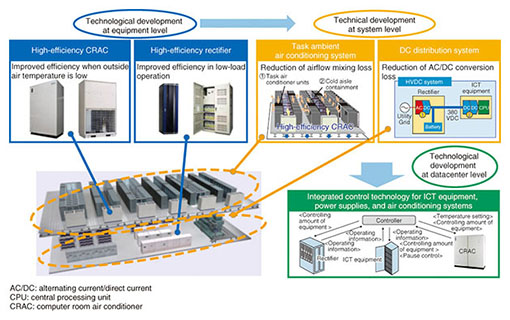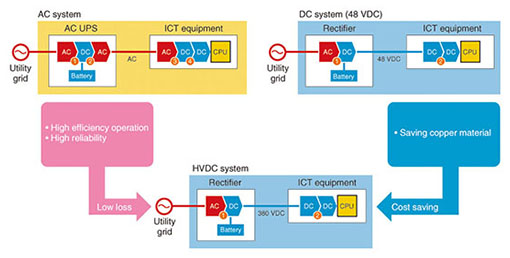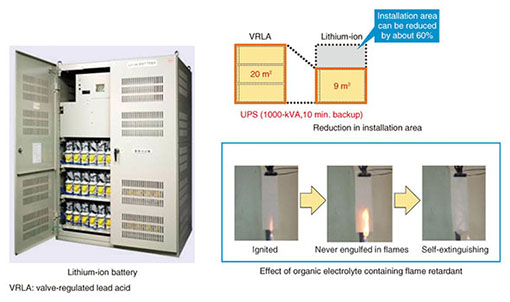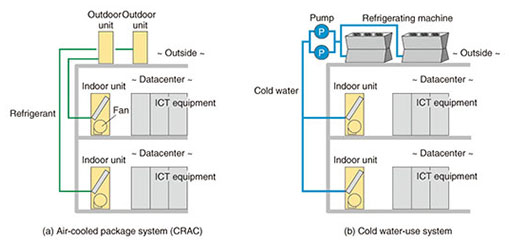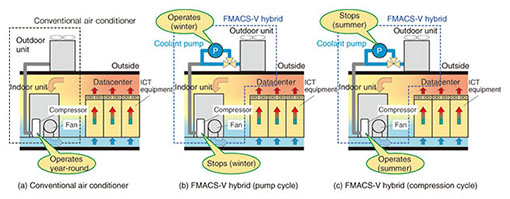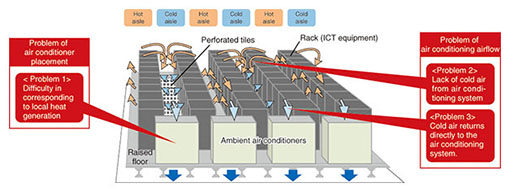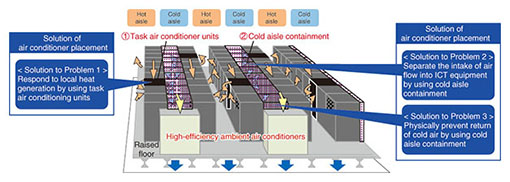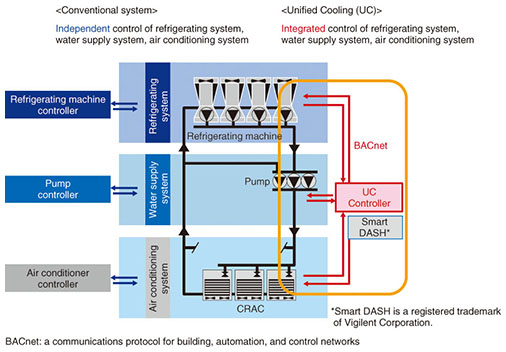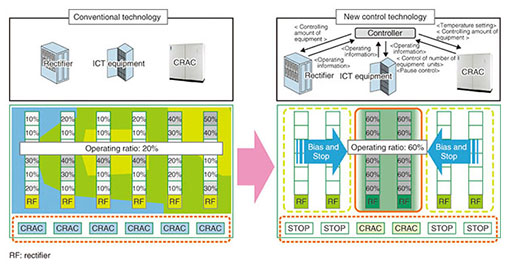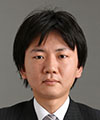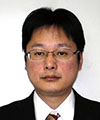 |
|
|
|
|
|
Feature Articles: R&D Efforts at NTT FACILITIES Vol. 12, No. 11, pp. 59–66, Nov. 2014. https://doi.org/10.53829/ntr201411fa10 Power Supply Technology and Air Conditioning Technology for ICTAbstractTo address the problem of reducing the power consumption of information and communication technology (ICT) buildings, NTT FACILITIES has been developing strategic technology for power and air conditioning systems from the equipment level such as highly efficient rectifiers and air conditioners, to the system level such as high voltage direct current power supply systems and task ambient air conditioning systems. Here, we introduce our power supply technology, air conditioning technology, and integrated control technology for ICT equipment, power supplies, and air conditioning systems that have been developed as part of our efforts toward reducing power consumption. Keywords: datacenter, power supply, air conditioning 1. IntroductionIn recent years, information and communication technology (ICT) equipment has come to play a bigger role in our daily lives, as it supports our social and economic activities. Communication buildings and datacenters manage ICT equipment centrally, and as ICT equipment continues to permeate our society, the importance of these facilities as social infrastructure increases. The amount of power consumed is increasing in parallel with the growing importance of these ICT buildings and facilities, and reducing power consumption has therefore become an important issue. Communication buildings that house ICT equipment also contain power equipment that drives the ICT equipment and air conditioners that cool the ICT equipment. NTT FACILITIES has been contributing to reducing ICT power consumption for over 30 years by conducting research and development on power and air conditioning technology and producing practical results. Our efforts in developing such technology have resulted in the stepwise development of technology from the equipment level, for example, highly efficient rectifiers and air conditioners, to the system level, including high voltage direct current (HVDC) power supply systems and task ambient air conditioning systems. However, there are limits to achieving further reductions of the overall power consumption of ICT buildings through improved power and air conditioning technology alone. Therefore, as we develop technology for controlling power supplies and air conditioning systems, we are also focusing on ways to include the ICT equipment in the control technology (Fig. 1).
Our work in this area has been received well by scientific associations in Japan and other countries and by various organizations outside the NTT Group, and it has received various awards. In this article, we describe our power supply and air conditioning technology as well as our integrated control technology for ICT equipment, power supplies, and air conditioning systems, which is designed to further reduce power consumption. 2. Power supply technologyICT equipment operates continuously—24 hours a day, 365 days a year—and the power it consumes is increasing. For these reasons, systems that supply power to the ICT equipment are required to have both high efficiency (low loss up to when the power is supplied to the ICT equipment) and high reliability (no interruption of the power supplied to the ICT equipment). Since the days of the Nippon Telegraph and Telephone Public Corporation, NTT FACILITIES has been working on equipment development, system design, and facilities maintenance technology in parallel with the evolution of network services. In our past work, we have had success in reducing power consumption in ICT, but while the power consumption of conventional switches and transmitters has been less than 1.8 kW per rack, the most recent high-capacity routers and servers may consume as much as 15 kW per rack. There is thus a need to develop a way to supply power with both high reliability and high efficiency. 3. HVDC power supply systemsDatacenters conventionally supply alternating current (AC) power to ICT equipment via an uninterruptible power supply (UPS). The UPS is connected to storage batteries to provide backup in the event of an interruption of the commercial power supply. The charging current for storage batteries is DC. AC power supply systems convert the AC power to DC and then convert the DC back to AC. It is then necessary to again convert the AC to DC inside the ICT equipment. There is thus a total of four power conversion steps in an AC power system, and power loss occurs at each step. In the DC power system that we recommend as a solution to this problem, AC power is converted to DC and is then supplied directly to the ICT equipment, thus reducing the power conversion to two steps. To achieve even higher efficiency, we are working toward changing the conventional DC power supply voltage of 48 V or so to a higher voltage of 380 V in an HVDC power supply system (Fig. 2). Doing so results in a current reduction of one-eighth for the same transmitted power and a reduction in wiring loss between the highly efficient rectifier and the ICT equipment. In parallel with that work, we have also been working on the development and standardization of DC power sockets and plugs to maintain the safety and simplicity that are needed in the operation of ICT equipment.
Storage batteries are needed for a highly reliable power supply, and we have developed flame-retardant lithium-ion batteries that are lighter and require up to 60% less space than lead-acid storage batteries (Fig. 3). The lithium-ion batteries have a flame-retardant additive in the electrolyte to prevent fire or rupture in abnormal conditions for increased safety. Adopting the flame-retardant lithium-ion batteries can both save space in electrical rooms and conserve material resources used for base frame by reducing the weight of the equipment.
4. Air conditioning technologyICT equipment generates a large amount of heat during operation, and consequently, it is cooled by special air conditioning systems. Generally, ICT equipment is cooled by placing air conditioning units along a wall and using the area below a raised floor as an air flow space for the cooling air. To cope with the higher heat density within the room that has come with the change from analog to digital ICT equipment and conversion to IP (Internet protocol), we developed special air conditioning technology for ICT equipment. Here, we describe the FMACS®-V (facilities multiunit air conditioning system-5th generation) hybrid, which is an indirect outdoor air-cooled package air conditioner for ICT equipment. We also describe a task ambient air conditioning system. The FMACS-V and other conventional mainstream air conditioning systems are air-cooled package-type air conditioners that can easily accommodate successive expansion of ICT equipment and can also be backed up by other air conditioning units when a failure occurs, thus providing high reliability (Fig. 4(a)). However, customer needs have been diversifying in recent years, and more large scale datacenters now demand cold water air conditioning systems, which can hold down the initial costs (Fig. 4(b)). To respond to the wider customer needs, we developed our Unified Cooling system to a practical level. Unified Cooling involves control of the overall system to achieve high efficiency in a cold water air conditioning system.
5. FMACS-V hybridICT equipment generates a large amount of heat in normal operation, and to cool that equipment, conventional air conditioning units use compressors throughout the year (Fig. 5(a)). The FMACS-V hybrid system, on the other hand, uses a coolant pump together with a compressor. During the winter and other times when the outdoor air temperature is low, air conditioning units perform cooling by using the coolant pump and the cold outdoor air with the indirect outdoor air cooling method (Fig. 5(b),(c)). The coolant pump can operate on about one-eighth the power needed by a compressor, so the energy saving is proportional to the coolant pump operating time. Thus, the effect in reducing power consumption is high in regions where the outdoor air temperature is low throughout the year. The annual power consumption of the FMACS-V hybrid is up to 54% less than that of conventional air conditioning units in Sapporo and up to 42% less in Tokyo. Therefore, this system can contribute greatly to reducing the power consumption of air conditioning systems.
6. Task ambient air conditioning systemsA task ambient air conditioning system combines ambient air conditioning, in which wall-mounted air conditioning units cool the entire room, and task air conditioning, in which a local area is cooled. Because air conditioning systems for ICT equipment produce about 20 times as much cold air flow as office air conditioning systems, an effective way to reduce power consumption is to reduce the power needed to produce the air flow. Ambient air conditioning facilitates successive expansion through rearrangement of the ICT equipment and the perforated panels through which cold air is drawn up from the floor. However, the following problems make it difficult to reduce the power needed to move air (Fig. 6).
6.1 Air conditioning unit placementWith ambient air conditioning, generation of high local heat requires that air be moved from wall-mounted air conditioning units to distant ICT equipment via a raised floor. A large amount of power is needed to drive the air movement. 6.2 Air conditioning air flowWith ambient air conditioning, cool air from the air conditioning units passes through the space beneath a raised floor and then through a perforated panel to reach the front side of the ICT equipment. It then passes through the inside of the ICT equipment where it is heated and then returned to the air conditioning units. However, if insufficient cool air is supplied from the perforated panels in the cold aisle (the corridor from which cool air is supplied), the high-temperature exhaust recirculates from the hot aisle (the air exhaust corridor for the ICT equipment) to the cold aisle, and the target temperature for the air drawn into the ICT equipment cannot be maintained. To maintain the ICT equipment air intake temperature, ambient air conditioners lower the temperature of the entire room to the set temperature. In that case, it is often not possible to deal with excessive air flow, resulting in inefficient operation. Also, some of the cool air from the air conditioning units is returned directly to the air conditioning units without cooling the ICT equipment, which is a further waste of power for the air flow. 6.3 Solutions to problemsA task ambient air conditioning system that can solve the two problems of ambient air conditioning systems (Fig. 6) is shown in Fig. 7. The task ambient system uses 30% less power than the ambient system. Specific solutions include those described below.
The problem of air conditioning unit placement is solved by using indoor air conditioning units that have the same form factor as the ICT equipment racks. This makes it possible to install FTASCL®-RS/C (facilities task cooler rack-shaped/compressor type) task air conditioner units near the ICT equipment that generates relatively high heat. Although wall-mounted air conditioning units must move a large volume of cool air a long distance through the raised floor space to deal with hot spots, the FTASRL-RS/C unit takes air in from the back side of the air conditioning unit and expels it to the front side, so the air flow distance is shorter, and less power is used for air transport. The problem of the air flow of air conditioning can be addressed by capping the cold aisle to physically prevent recirculation of hot exhaust air to the cold aisle. It is also possible to prevent the cool air from being returned directly to the air conditioning units. Solving the air flow problem with cold aisle containment means that power can be saved by reducing the power needed to produce the air flow and by optimizing the temperature settings. 7. Unified CoolingThe main type of air conditioning systems used in datacenters has been the air-cooled package system, which comprises one indoor unit and one outdoor unit (Fig. 4(a)). In recent years, however, the diversification of customer needs has led to an increase in the use of cold water systems. Air conditioning systems that use cold water consist of a refrigerating system that produces the cold water, a water supply system for transporting the water, and an air conditioning system for cooling the room with the transported cold water. Each of these systems comprises multiple units of equipment (Fig. 4(b)). Conventional cold water air conditioning systems use separate controls for the refrigerating system, water supply system, and air conditioning system (Fig. 8), and there is no overall energy-conserving operation of the system. We therefore developed Unified Cooling (Fig. 8), which provides unified control of all three subsystems to achieve overall energy efficiency for the entire system. In maintaining the specified room environment, the Unified Cooling system adjusts the settings for the output temperature of the thermal system and the pressure of the water transport system. Integrating this control with Smart DASH®, which controls the air flow of the air conditioning system, makes it possible to reduce power consumption by up to 30%.
8. Integrated control technology for ICT equipment, power supply, and air conditioning systemsIn recent years, large variations have been observed in the amount of data processing done within certain time periods by datacenter ICT equipment. ICT equipment generally has high energy efficiency when operated under high-load conditions, but low-load operation occurs routinely. Also, the correlation between ICT equipment power consumption and the amount of data processing is not proportional; a constant amount of power is being consumed even in standby states when no data processing is being done. Thus, power is being wasted when data is not being processed. An efficient operating state can be maintained by shifting the processing to particular ICT equipment in time periods when the amount of data processing is low. Doing so makes it possible to turn off the power to ICT equipment that is in the standby state, thus reducing power consumption. Reducing the power consumption also reduces the sources of heat generation, so it may be possible to halt the operation of some air conditioning units. A sequence of controls of this kind (Fig. 9) is expected to reduce the total power consumption by the ICT equipment, the rectifier, and the air conditioning units by at least 50% compared to ordinary datacenter systems.
This work was conducted in collaboration with the NTT Energy and Environment Systems Laboratories. 9. ConclusionIn this article, we reviewed power supply and air conditioning technology. We also described the integrated control technology we developed to control ICT equipment, power supplies, and air conditioning systems to further reduce ICT power consumption. We will continue working on technological development of such systems so as to continue contributing to the reduction of power consumption in the future. The FMACS-V hybrid and FTASCL-RS/C are being developed with the cooperation of Hitachi Appliances. |
|









